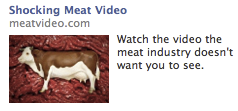“The headline is the ‘ticket on the meat.’ Use it to flag down readers who are prospects for the kind of product you are advertising.” – David Ogilvy
I couldn’t help but think of this quote when I came across the following ad:
 And it wasn’t the “ticket on the meat” analogy that recalled the quote (though that did help). What brought Ogilvy’s wisdom immediately to mind was the idea of:
And it wasn’t the “ticket on the meat” analogy that recalled the quote (though that did help). What brought Ogilvy’s wisdom immediately to mind was the idea of:
1) Speaking to a specific target audience
2) The value of Pay-Per-Click-based advertising when doing so
See, the people behind this ad probably don’t want you to watch this video if you have absolutely no intention of either becoming a vegetarian or vowing to only buy and eat organic, farm-raised meat. If you’re the kind of person that doesn’t want to be told what’s in a hot dog for fear that you’ll never be able to enjoy a hot dog again, then they’d rather not spend their click on you.
And how do they avoid that? They spell out exactly what’s on the other side of the hyperlink with the headline: a “shocking meat video.” But in case that’s not quite enough, they also use one of the most message-motivated pieces of creative imagery I’ve yet to see on a Facebook ad. The toy cow resting on top of the raw hamberger meat says it all, doesn’t it?
So lots of people are sure to notice the ad when it’s displayed to them, because the red meat background is high contrast and because the image itself is so visually striking and emotionally disturbing. But only those people who are interested in the message will click.
Because the goal isn’t just to get the Click-Through, but to get the Click-Through from well-qualified and conversion-ready prospects.
A Few Takeaways
1) Are you testing for both conversion and CTR, or just CTR?
2) Have you tested headlines that act as “The ticket on the meat” of your offer? Headlines that allow your best prospects to self-identify and respond? Or have you stuck with a narrow range of predictable, redundant headlines?
3) Does your image reinforce the central message of your offer in an emotionally compelling format? Or are you just falling back on the same old “tricks” that every other advertiser is using to grab eyeballs?


